Admin
Sdk
gcloud cli
client libraries sdk linguaggi programmazione
bq bigquery
gsutil cloud storage
Resource hierarchy
Projects: contains all resources, lowest level of org
Organization: top level hierarchy, contains all folder, all projects
- need a cloud identity or a google woekspace account
Folders: logic group of projects
Google Cloud Console’s Resource Manager: console for manage folder, projects and org
Projects metadata
Project name:
- name of the project
- can be edited
Project id
- Globally unique id
- immutable
- used by gcloud commands and apis
Project Number
- globally unique
- cannot be chosen or modified
- used internally
Enabling apis:
- add apis to project for use services
Projects migrations
Project migration: project can be migrated accross different folder / org
projects.move: apis that facilitated the project move
- resourcemanager.projects.update: permission on the project being moved
- resourcemanager.projects.move: permission on the destination
Roles at org level
Organization administrator: admin of the org
Organization policy administrator: manage org policy
VIewer: view only access
Browser: read only accesso to structure and projects folders metadata
IAM
Principal: entity that can be granted access to resources
- Use accounts:
- Human
- Access with password and username
- access to cloud services
- Service account
- access via keys and token
- associated with app and vm
Service account admin role: create and manage service account
Google managed vs user managed service account
- google created
- pre defined name
@ .gserviceaccount.com - default permission
User
- User created
- custom name
@ .iam.gserviceaccount.com - custom permission
Roles
Basic
Owner : full access to resources
Editors: full access read write to most resource cannot manager roles and permission
Viewer: read only access
Predefined
Predefined roles for gcp service and apis
Examples:
Compute Engine Admin
Cloud Run Developer
Storage Object Viewer
Custom
Defined by user
Access approval
Designe an approver on the team to review and decide wheter to approve or not access request from google support team
Pricing calculator
no log web console for predict future cost
billing console historical cost on past, pricing caluclator on the future
Cloud billing
Billing console: console for manage billing
Project billing manager: associate a project to a billing account
Billing administrator: associate a project to a billing account at org level
Billing administrator: can setup billing allert
Big Data
Dataflow
Apache Beam (batch and stream)
handle separate data stream of different types
Integration with cloud storage, pub/sub, big query
Pipelines are single region
Pub/sub
Google version of kafka
global scale servless message buffering
Integration with dataflow:
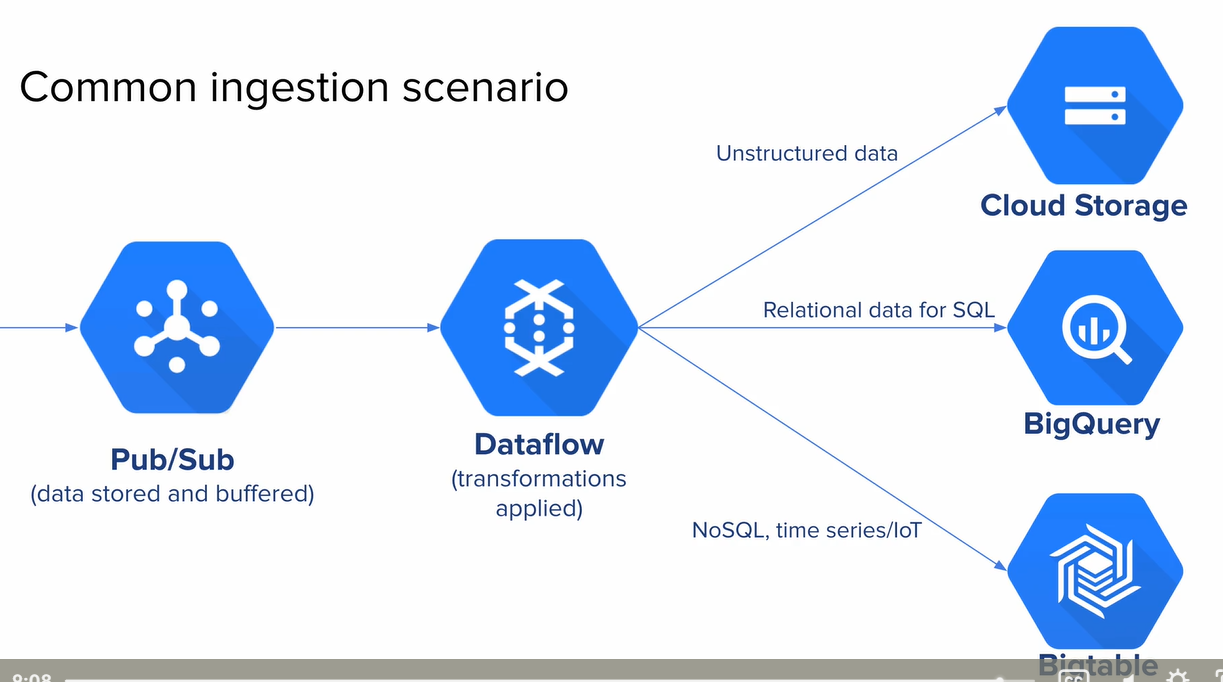
Compute Services
Google Compute Engine
Virtual Machine on Cloud
Setup VM
- Region, Zone
- Machine Type
- ex e2-standard-2 (number of vcpus)
- OS
- Boot disk size
- spot or not
- Network settings
- firewall rule
- net tags
- external ip
- Monitoring
- Ops agent
- Service account
- Delete protection: protezione dalla cancellazione dell’istanza
- On Host maintenance: comportamento vm quando google manipola infrastruttura fisica
Remote Access
- SSH: ssh key managed by google
- Os Login: check if user has roes for ssh access
- Compute OS Login: login ssh no root
- Compute Os Admin Login: login ssh root
- Compute OS Login External User: login ssh external of gcp no root
- RDP: ssh of windows
- gcloud compute reset-windows-password : genera password per rdp
- set user/password under remote access in compute engine
OS Config Agent
Agent for vulnerability scanning and access OS metadata for find vulnerabilities
roles/osconfig.vulnerabilityReportViewer role for view vulnerability
Managed Instance groups
Simplify deployment and management of VM.
Auto updates, auto scaling, high avilability, load balancing
Autoscalig signal: signal for autoscaling → cloud monitoring metric, cpu utilization. load balancer utilization, …
Healt check: monitor VM statuts → should be bigger than vm boot
Autohealing: recreate unhealthy vm
Automatic restart: restart vm after a crash
Deployments
Gradual:
- maxSurge: max number of new instances that can be created
- maxUnavailable: max numer of instances that can be unavailable during update
Instance Template
Blueprint for vm: machine type, image, disk, …
Backup and disaster recovery
Zonal Failure Protection: multi-zonal deploy
Scheduling Backup: schedule snapshot
Roles
Compute Storage Admin for creating snapshot
Compute Admin control over all google compute engine
Compute Instance Admin managing vm instances settings: os disk net …
Compute Viewer read only to all compute engine resource and metadata
Kubernetes and GKE
Cluster: collection of nodes
Node: worker machine within a cluster
Pod: deploy unit in an node (can contain 1+ container)
K8s structure
- Services: expose k8s node and pods from outside of cluster
- ClusterIP: pod to pod comunication
- NodePort: external client to pod without balancing throught nodes
- LoadBalancer: external client to pod with auto distribution within nodes
Commands
kubectl config use-context: switch between .kube/config config
kubectl config view: view current .kube/config config
gcloud container clusters get-credentials my-cluster: retrieve .kube/config
Nodes
Preemptive node: Spot nodes, can be reclaimed by google at any time
Node pools: nodes with different machine type
Node labels: settings label
Node selector: field of k8s manifest for specifie node from labels
Features
Cluster Autoscaler autoscale number of node (best practicies set min and max)
Horizontal Pod Autoscaler scale number of pod based of usage
Vertical Pod Autoscaler
Auto-Upgrades: auto upgrade to the next k8s version. release channel:
- Rapid channel: prioritize new features (test and dev)
- Regular channel: balance new features and stability (pre-prod)
- Stable channel: prioritize stability (on prod)
Config connector
manage gcp resource with kubectl and k8s (crossplane)
delete config connector: kubecctl not gcloud
Filesystem
persistent storage persistent ssd
local storage ephemeral high io
filestore shared
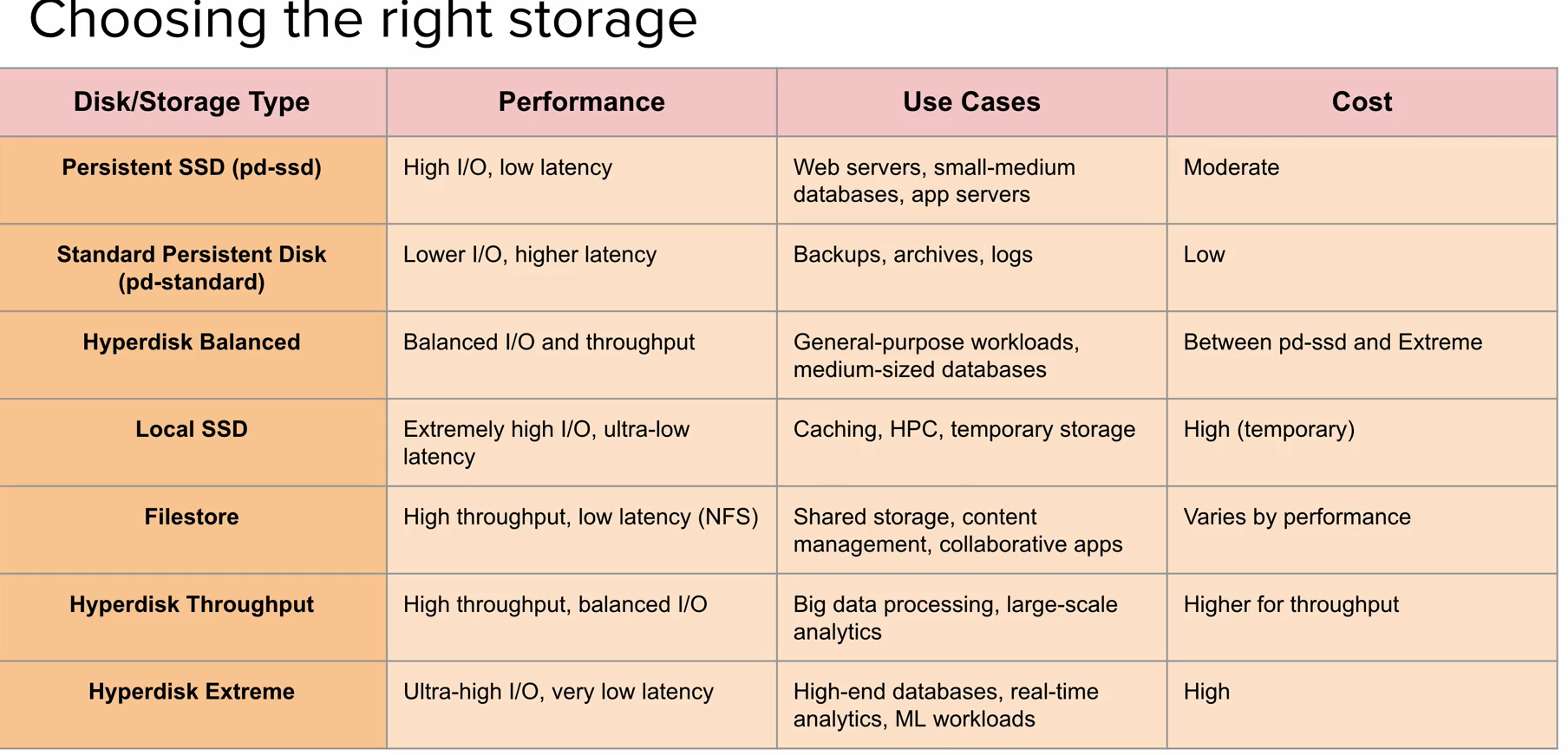
Cloud logging
cluster setting: enable logging
disable logging for a container in ingestion setting of cloud logging
Workloads
StatefulSet k8s object for mamage storing data
DeamonSet replicate a pod in every or select node
Commands
gcloud config set container/cluster
gcloud container cluster create
gcloud container node-pool create
gcloud container cluster list
Cloud Run
Platform servless for run stateless container. can scale to zero,automatic horizontal scaling
Cold start fix
- Minimum number of instances: setup a minimum number of instances always running
- Pre warming: make fake traffic for keep instance alive periodically
App Engine
- Servless application deploying
- 1 app engine 1 project
- Regional (cant be changed)
Standard vs Flexible
- Standard: low cost/free can scale to zero, extreme spike traffic
- Flexible: docker container environment
Scaling
- Basic scaling: add new instances for every request. Shutdown instances when application is idle
- Automatic scaling: add new instances in base of applications metrics: Can setup a minimum numebr of instances running all the time
- Manual scaling: setup the number of instancs
App Engine Versions
- Page with all version deployed
- You can return to a previos version route all traffic to the previous
App settings
in yaml file
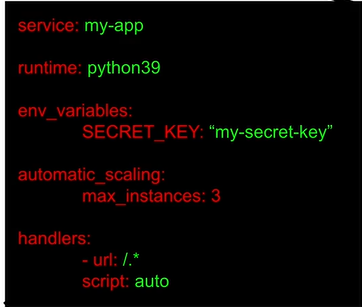
Data governance
Data catalog
Repository of data
metadata management: create store and manage metadata for all gcp data resources
data discovery and search: search data accross gcp services
tagging and tag tempaltes
Data storage
Google Compute Storage
gsutil
gsutil cp
gsutil rsync
gsutils ls
Storage classes
Lifecycle rule → change between classes or delete
| days | use cases | |
|---|---|---|
| standard | frequent | |
| nearline | 30g | 1 month |
| coldline | 90g | disaster recovery |
| archive | 365 | 1+ year |
Location
Regional regionale (low latency)
Multi-regional multi/region HA min latecy
Dual-region disaster recovery
Versioning
verisoning object
gsutil versioning set on/off gs://
GCS Access
IAM Policy: basic predefined custom roles → object level requires conditional iam policies
ACLS: object level only → owner, writer, reader, object level only
Signed Urls: temproary access with predefined read or write
Roles
storage admin: full control
storage object admin: manage objects in bucket
storage object creator: upload objects in bucket
sotrage object viewer: read objects of bucket
storage legacy bucket reader: read bucket metadata and data
Trigger action
object upload
object delete
object metadata upload
object archived
integrate with: pub/sub, cloud function, cloud run
Integration with services
Dataflow: input/output
Dataproc: replace hadoop file system for dataproc (spark/hadoop)
Cloud Spanner
Global availability global scalability global consistence relational DB
Monitoring health: →roles/monitoring.viewer
raccomendend cpu usage threshold for single-region 65%
raccomendend cpu usage threshold for multi-region 45%
Improve read performance → create secondary index
Cloud SQL (sql db)
SQL Db (postgresql, mysql, sqlserver)
OLTP workflow → transactional insert,update,delete
MAX Storage = 64 TB
Point in time recovery: restore at any paste state
MYSQL: binary logging
PostgreSQL: write ahead logging
Read Replica: HA async replication (same region of master)
Failover Replica: HA disaster recovery ****sync replication ****(different region or zone)
Backups:
- Automatic
- 7 days of retention → export to cloud storage for more time
- backup window
- Manual
- Scheduled
Cloud SQL proxy: connect app to db through iam based auth (encrypted) cloudsql.instances.connect
Firestore (nosql db for realtime)
Fully-managed Real time nosql db
Memorystore (caching redis/memcached)
Fully-managed in memory data store (caching layer)
Support redis and memcached
Bigquery (datawarehousing)
fully managed sql db storage and analyctics and data warehouse
OLAP workflow: analysis
sql query for retrieve data
pay for query data retrieve
- bq cli for preview the number of bytes to retrieve
Job error: job explorer area
Cost control
- Quotas: se up custom query quotas per user or project → quotaERxceed error
- Flate-rate princing: flat monthly cost
BigQuery admin console
Resource utilization and jobs monitoring
INFORMATION_SCHEMA: schema for get info about jobs, datasets, table,….
Roles
- bigquery admin: full control of bigquery (project level)
- bigquery user: create dataset and manage jobs
- bigquery data owner: manage and share datasets/views
- bigquery data editor: modify and delete table data
- bigquery data viewer: read only tables
- bigquery job user: run jobs and queries
- bigquery metadata viewer: access dataset/table metadata
Looker
data intelligence business inteliggence data dashboard from bigquery
looker studio: free, basic data visualization
looker: paid version, customizable bi analysis, high customization
Bigtable (nosql db for analysis)
Service: fully-managed nosql database
Use case: analytics workloads
Payment: dont pay for empty cells
Row: row key is index (best practicies: string id, reverse domain, timestamp column)
Logging: resource.type=”bigtable_instance”
Deployments
Container Registry
Registry for docker images
storage object viewer: roles for pull
Artifact registry
registry fore store artifacts
artifact registry viewer artifact registry reader, pull images role
Cloud Build
ci/cd
testing
permissions denied error
Cloud Deployments Manager
terraform
simulating deploments —preview (plan) gcloud deployment-manager deployments create my-deployment —config config.yaml —preview
Marketplace
Online store that offer ready-to-deploy solution
Migrate
Migrate for Compute Engine (formerly Velostrata)
Networking
VPC
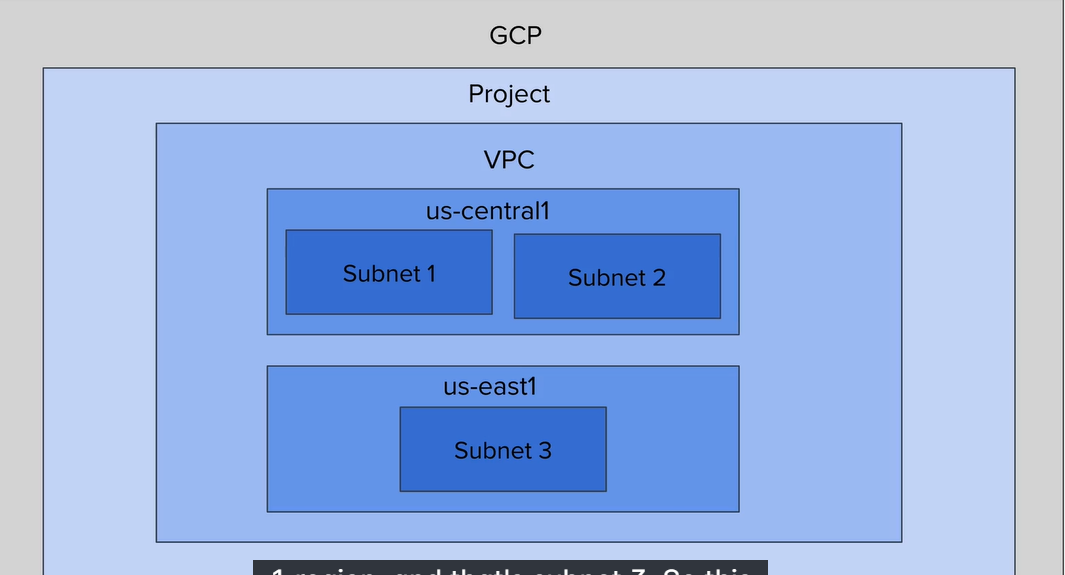
Subnet: at region leve in a vpc
vpc: at project level+
Private Service Connect
App accessible only through an internal ip in the vpc
Private Google Access
connect to google apis and service without external ip
Shared Vpc
share vpc from one project to another in same org
VPC Peering
Peerin 1-1 of 2 vpc
Cloud VPN
vpn connection from on-prem&/vpc to cloud vpc
Common ip
0.0.0.0/0 default route for all ip
10.0.0.0/8 reserved for private net
172.16.0.0/12 reserved for private net
192.168.0.0/16 reserved for private net
8.8.8.0/24 reserved for dns
192.0.2.0/24 reserved for docs and examples
Firewall
Identity-based firewall rules: firewall lrule in base of service account
Logging: disabled by default → enable in logs section of the rule
Load balancing
Distribute traffic between services
static ipv4 and ipv6 (frontend)
SSL Termination (terminate https encryption at load balancing for simplify certificates management)
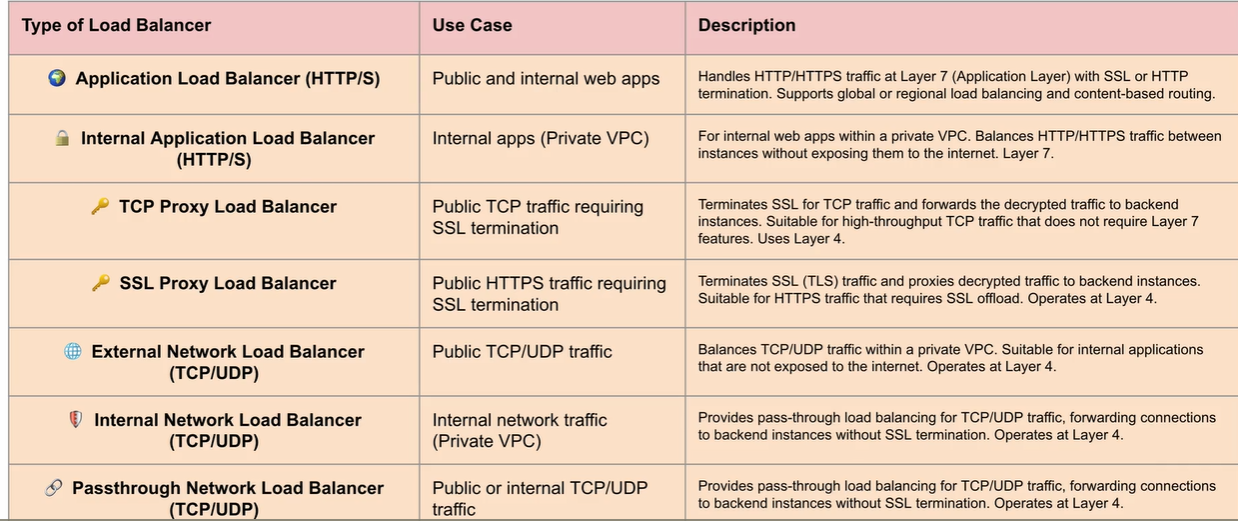
A records ipv4
AAAA records ipv6
CNAME records to another cname
Cloud Identity-Aware proxy
grant access to vm or web app verifying the identity before log
protect resources: cloud run, app engine, https load balancer, google compute engine
auth types: oauth, jwt, google sign in, microsoft sign in
defense: brute force attack
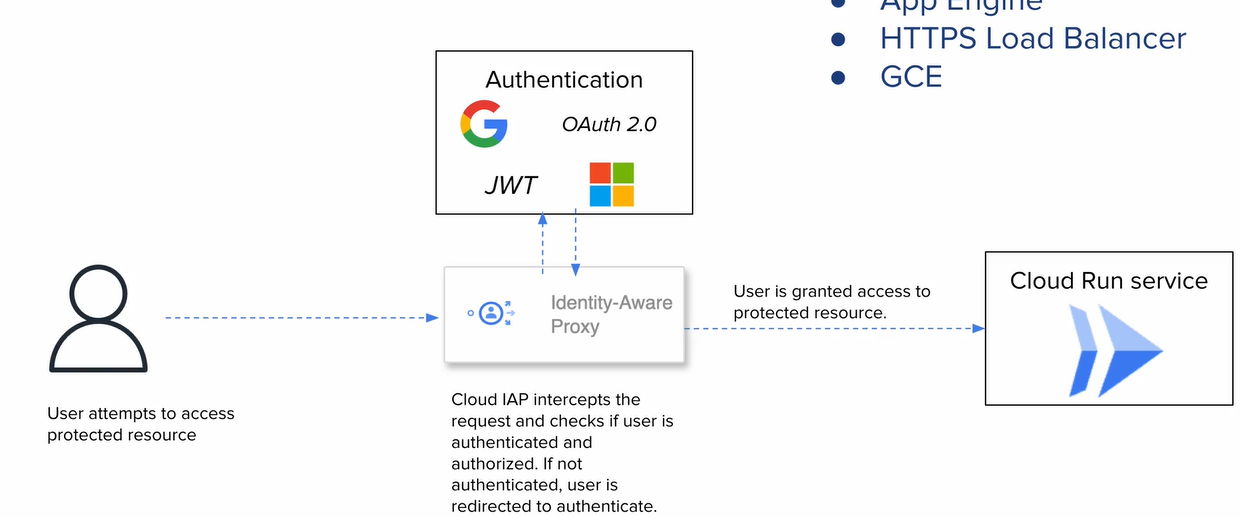
Observability
Cloud Logging
Service that store, analyze, search all logs
integration with cloud monitoring for analytics and automated alert
Logs
Log info:
- Admin activity
- Data access
- System event
- User log from app
Retention period:
- Default period: 30 days
- Custom: custom log retention
Log sinks: export destintion for logs

SIEMS: security logs

Audit Logs: access activity, user activity
Cloud monitoring
Collect analyze visualize metrics of gcp resoruces
Metrics
Infrastructure: cpu use disk i/o, network
Application: repsonse time, error rate, latency, request rates
Custom:
External: multi-cloud
System: system load
Alert
Real time alert in base of metrics
Notification: sms email third party
Multi-project
Select primary project
Link projects to console
Cloud Trace
Inspect latency and issue of app and request flow
Cloud Debugger
debug production app without stop
Cloud Profiler
analyze code and performance of the app